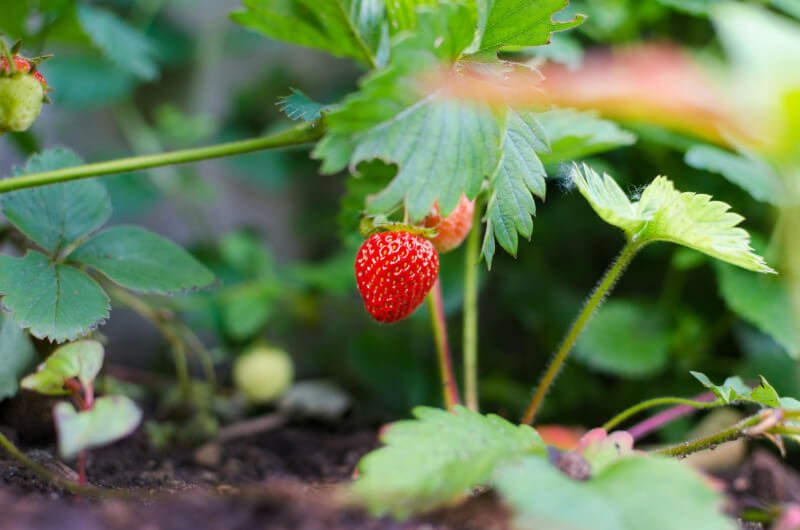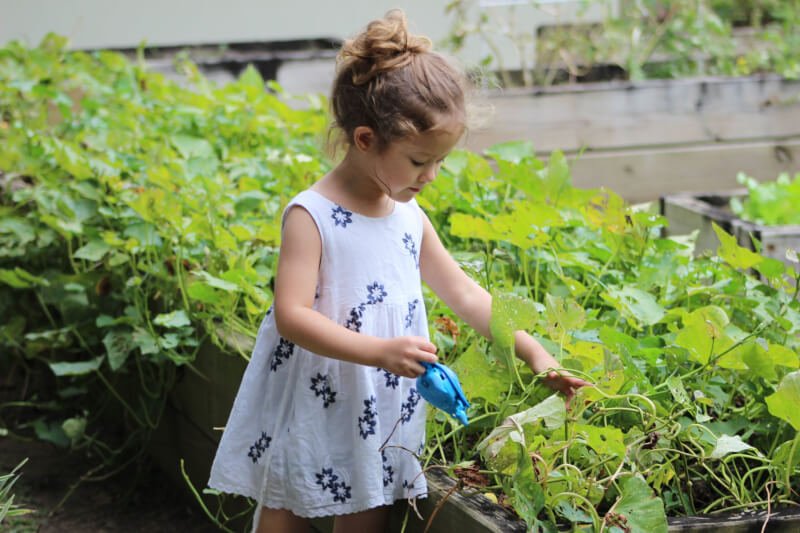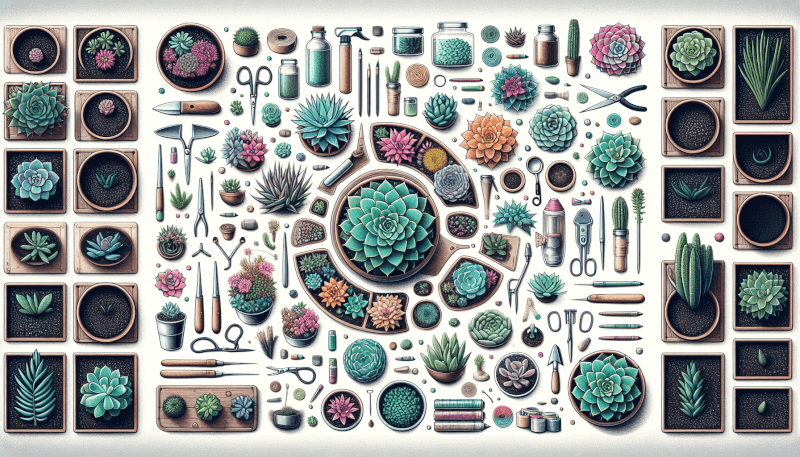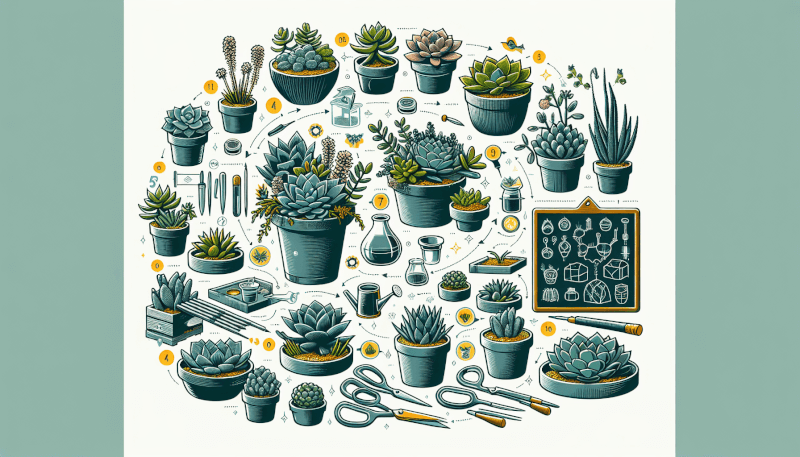Creating a DIY succulent garden has never been easier, and the best ways to do it are simpler than you might think. In this article, we will explore some of the most effective techniques for creating your very own stunning succulent garden. Whether you’re a seasoned gardener or a complete beginner, these methods will guide you step by step, making it a fun and rewarding project for anyone. So gather your materials and let’s get started on transforming your space into a vibrant oasis of greenery and beauty.

Choosing the Right Succulents
When it comes to creating your own DIY succulent garden, choosing the right succulents is crucial for a successful and thriving garden. Before heading out to a nursery or garden center, take some time to research different types of succulents. There are numerous varieties with varying shapes, sizes, colors, and growth habits, so it’s important to find ones that appeal to you and suit your garden space.
Consider the climate and environment in which you live. Succulents are known for their ability to withstand dry conditions, but some varieties may be more suited for hot, arid climates while others may thrive in cooler, more humid environments. Make sure to select succulents that are well-suited to the specific conditions of your area to ensure their long-term success.
Another important factor to consider when choosing succulents is their health and establishment. Look for plants that are healthy and free from pests or diseases. Avoid succulents with mushy or discolored leaves, as these may indicate underlying issues. Opt for well-established plants with a strong root system, as they will have a greater chance of survival when transplanted into your garden.
Preparing the Garden Area
Once you’ve chosen the right succulents for your DIY garden, it’s time to prepare the garden area for their arrival. Follow these steps to ensure a suitable environment for your succulents to thrive.
Find a Suitable Location
Select a location in your garden that receives ample sunlight. Most succulents require at least six hours of direct sunlight each day to maintain their vibrant colors and compact growth. Avoid areas with excessive shade or areas that are prone to waterlogging, as this can lead to root rot and other issues.
Clear and Level the Ground
Before planting your succulents, clear the ground of any weeds, rocks, or debris. Level the area to ensure an even surface for your garden. This will make it easier to arrange and care for your succulents.
Improve Drainage
Succulents are highly susceptible to root rot if they are exposed to standing water for prolonged periods. To improve drainage in your garden, consider adding organic matter such as compost or well-rotted manure to the soil. This will help increase its ability to retain moisture while allowing excess water to drain away.
Prepare the Soil
Succulents thrive in well-draining soil with good moisture retention. If your garden has heavy clay or sandy soil, it’s important to amend it before planting. Mix in some coarse sand or perlite to loosen up the soil and improve drainage. Adding organic matter, such as peat moss or compost, will also improve the soil’s fertility and water retention capacity.
Designing the Garden Layout
Designing the layout of your DIY succulent garden is not only exciting but also an opportunity to showcase your creativity. Follow these steps to create a visually appealing and harmonious garden design.
Plan the Overall Design
Before diving into the planting process, take some time to plan the overall design of your succulent garden. Consider the available space, the shape of the area, and any existing landscaping features. Explore different design styles, such as geometric patterns, mixed beds, or container arrangements, to find one that suits your taste.
Consider Color, Texture, and Size
When selecting succulents for your garden, consider the colors, textures, and sizes of the plants. Succulents come in a wide range of hues, from vibrant greens to deep purples, and even striking variegated varieties. Mix and match different colors to create a visually stunning display.
Texture is another important aspect to consider. Some succulents have smooth, fleshy leaves, while others have spiky or textured surfaces. Combining different textures adds interest and depth to your garden.
Additionally, keep in mind the mature size of the succulents. Some varieties stay small and compact, while others can grow tall and wide. Plan accordingly to ensure that you provide enough space for each plant to thrive without overcrowding.
Create Visual Interest with Contrasting Forms
To create visual interest and a well-rounded garden design, experiment with contrasting forms and shapes. Pair succulents with different growth habits, such as rosette-shaped plants with tall, spiky ones, or trailing varieties with upright ones. This combination of contrasting forms adds dimension and creates a dynamic visual appeal.
Planting Succulents
Now that you have prepared the garden area and designed the layout of your succulent garden, it’s time to get your hands dirty and start planting. Follow these steps to ensure proper planting and establish healthy succulents.
Prepare the Plants for Planting
Before planting your succulents, gently remove them from their nursery pots. Gently loosen the roots and remove any excess soil if necessary. This will help the roots establish in their new environment more effectively.
Dig Properly Sized Holes
Dig holes in the prepared soil that are slightly larger than the root ball of the succulent. This will allow ample space for the roots to spread out and establish themselves.
Arrange the Plants
Place the succulents in the prepared holes, ensuring that they are positioned at the same depth as they were in their nursery pots. Arrange them according to your planned garden layout, considering their size, color, and form.
Backfill and Firm the Soil
Once the succulents are in place, carefully backfill the holes with the prepared soil mixture. Gently press the soil around the roots to ensure good soil-to-root contact and eliminate any air pockets.
Water the Succulents Thoroughly
After planting, water the succulents thoroughly to help settle the soil around the roots. Water until the soil is evenly moist but avoid overwatering, as succulents are prone to root rot if they sit in standing water.

Caring for Succulents
Caring for your succulents is essential to keep them healthy and thriving. Follow these guidelines to provide the best care for your DIY succulent garden.
Provide Adequate Sunlight
Succulents thrive in bright, indirect sunlight. Place your garden in a spot that receives at least six hours of sunlight per day. If growing indoors, place the garden near a sunny window or use artificial grow lights.
Water Properly and Avoid Overwatering
Succulents are adapted to survive in arid climates and have unique water storage abilities. Allow the soil to dry out between waterings, and avoid overwatering which can lead to root rot. As a general rule, water your succulents when the top inch of soil feels dry.
Monitor for Pests and Diseases
Keep a close eye on your succulents for any signs of pests or diseases. Common pests that can affect succulents include mealybugs, aphids, and scale insects. Treat infestations promptly using organic insecticides or by washing the affected areas with mild soapy water.
Fertilize Occasionally
While succulents don’t require heavy feeding, occasional fertilization can help promote healthy growth. Use a balanced, water-soluble fertilizer diluted to half the recommended strength. Apply during the growing season, typically in spring and summer, and reduce or cease fertilization in the dormant winter months.
Prune and Propagate when Necessary
Pruning and propagating your succulents can help maintain their shape, control overgrowth, and expand your succulent collection. Trim any dead or decaying leaves or stems and propagate healthy cuttings to grow new plants.
Adding Decorative Elements
Enhancing your DIY succulent garden with decorative elements adds a personal touch and elevates its aesthetic appeal. Consider these ideas to make your garden visually captivating.
Choose Suitable Garden Accessories
Select garden accessories that complement the overall design of your succulent garden. Decorative pots, plant stands, and trellises can add height and interest to your garden, while decorative stakes and labels can provide a whimsical touch.
Use Rocks, Pebbles, or Gravel for Visual Appeal
Incorporating rocks, pebbles, or gravel into your garden design can add texture and visual interest. Create pathways or borders using these materials to enhance the overall aesthetic appeal of your garden.
Incorporate Sculptures or Art Pieces
Adding sculptures or art pieces to your succulent garden can create a focal point and add a unique flair. From whimsical garden gnomes to contemporary sculptures, choose pieces that resonate with your personal style and enhance the overall ambiance of your garden.
Consider Using Containers or Planters
If you have limited garden space, or if you want the flexibility to move your succulents around, consider using containers or planters. Select pots that have proper drainage holes and are large enough to accommodate the mature size of your succulents.

Creating an Indoor Succulent Garden
If you don’t have access to an outdoor garden or want to bring the beauty of succulents indoors, creating an indoor succulent garden is a wonderful alternative. Follow these steps for a thriving indoor succulent garden.
Choose Suitable Containers and Planters
When selecting containers for your indoor succulent garden, consider the size, drainage, and aesthetics. Make sure the containers have drainage holes to prevent water from pooling at the bottom. Choose containers that complement your interior decor and provide a healthy growing environment for your succulents.
Consider Lighting and Temperature
Indoor succulent gardens require adequate lighting and temperature conditions for optimal growth. Place your garden near a sunny window where the succulents can receive at least six hours of bright, indirect sunlight per day. If natural light is limited, use artificial grow lights to supplement the lighting requirements.
Maintain a consistent temperature range between 60-80°F (15-27°C) for most succulents. Avoid placing them near drafts or vents as sudden temperature fluctuations can stress the plants.
Provide Adequate Drainage
To prevent overwatering and root rot, ensure that your indoor succulent garden has proper drainage. Place a saucer or tray under the containers to catch excess water and remove it promptly to prevent the soil from becoming waterlogged.
Use a Well-draining Potting Mix
Succulents require well-draining potting mix to prevent water retention and root issues. Use a commercial succulent or cactus potting mix, or create your own by mixing equal parts of potting soil, coarse sand, and perlite or pumice. This mixture will provide the necessary drainage and aeration for your succulents’ roots.
Rotate Plants for Even Growth
Indoor succulents tend to grow toward the light source, which can result in uneven growth and lopsided plants. Rotate your succulents every few weeks to ensure they receive even lighting on all sides. This will promote balanced growth and prevent plants from leaning or stretching toward the light.
Watering Techniques for Succulents
Proper watering techniques are essential for the health and survival of your succulent garden. Follow these guidelines to ensure optimal watering practices.
Watering According to the Season and Climate
Watering requirements for succulents vary depending on the season and climate. During the growing season, which is typically spring and summer, succulents may require more frequent watering. In contrast, reduce watering in the dormant winter months when succulents go through a period of rest.
Take into account the current weather conditions and adjust your watering schedule accordingly. Succulents exposed to high temperatures or dry climates may need more frequent watering, while those in cooler or more humid environments may require less.
Water at the Right Time of Day
It’s best to water your succulents early in the morning or in the late afternoon. Watering during these times allows the plants to absorb moisture before the heat of the day evaporates it. Avoid watering in the evening or at night, as this can create a humid environment and encourage fungal growth.
Use the Soak and Dry Method
The soak and dry method is a widely recommended watering technique for succulents. Instead of lightly misting or sprinkling your succulents, thoroughly saturate the soil until water drains out from the bottom of the container. Allow the soil to dry out completely before watering again. This method mimics the natural rainfall patterns in their native habitats and encourages healthy root growth.
Avoid Watering the Leaves
When watering your succulents, direct the water towards the base of the plant and avoid getting the leaves wet. Moisture on the leaves can lead to fungal diseases and sunburn if the plants are exposed to direct sunlight.

Dealing with Common Succulent Problems
Succulents, like any other plants, can encounter problems such as pests, diseases, and growth issues. It’s important to identify and address these issues promptly to prevent further damage. Here are some common succulent problems and how to deal with them.
Identify and Address Pest Infestations
Inspect your succulents regularly for signs of pests such as mealybugs, aphids, or scale insects. These pests can damage the leaves and stems of your succulents if left untreated. If you notice any pests, remove them manually or treat the affected areas with organic insecticides.
Prevent and Treat Root Rot
Root rot is a common issue in succulents, often caused by overwatering or poor drainage. To prevent root rot, ensure that your succulents are planted in well-draining soil and that the containers have proper drainage holes. If you notice signs of root rot, such as mushy or discolored roots, remove the affected plants and let the remaining healthy ones dry out before watering again.
Address Sunburn or Sun Damage
Succulents are adapted to withstand bright light, but prolonged exposure to intense sunlight can cause sunburn. Sunburn manifests as discolored or dried out patches on the leaves, usually in the form of brown or white spots. To prevent sunburn, gradually acclimate your succulents to direct sunlight and provide them with some shade during the hottest part of the day.
Trim or Control Overgrowth
Succulents can sometimes become leggy or develop unruly growth. To maintain a compact and healthy plant, trim back any overgrown stems or remove dead or decaying leaves. Pruning promotes new growth and helps maintain the overall shape and balance of your succulent garden.
Revive and Propagate Dying Succulents
If you have succulents that are looking unhealthy or dying, don’t despair. With proper care and attention, many succulents can be revived. Assess the root health and adjust your watering practices accordingly. If the plant is severely damaged, consider propagating healthy cuttings to create new plants.
Creating a Miniature Succulent Garden
Miniature succulent gardens offer a charming and compact alternative to traditional gardens. Here’s how you can create your own miniature succulent garden.
Choose a Small Container or Terrarium
Select a small container or terrarium that suits your desired design. The container should have proper drainage to prevent water from pooling at the bottom. Terrariums with a lid can create a humid environment suitable for certain succulent varieties.
Use Miniature Succulents and Accessories
Choose miniature succulents that will fit comfortably within the container or terrarium. Look for varieties that stay small and have a compact growth habit. Additionally, consider using miniature accessories such as tiny figurines, pebbles, or fairy garden elements to further enhance the miniature theme.
Create a Balanced Design
Plan and arrange your miniature succulent garden with consideration for balance and proportion. Position the succulents and accessories in a way that creates a visually appealing and cohesive mini landscape.
Provide Adequate Drainage
Ensure that your miniature succulent garden has proper drainage to prevent water from collecting at the bottom of the container. Use well-draining potting mix and adjust your watering techniques to prevent overwatering and root issues.
Use Suitable Potting Mix
Miniature succulents have small root systems and require a well-draining potting mix. Use a mixture of potting soil, coarse sand, and perlite or pumice to create a lightweight and porous medium that allows for proper air circulation and water drainage.
In conclusion, creating your own DIY succulent garden can be a rewarding and enjoyable endeavor. By researching different succulent varieties, preparing the garden area, designing the layout, and properly caring for your succulents, you can create a stunning garden that thrives and brings joy for years to come. Whether you choose to design an outdoor garden, an indoor oasis, or a miniature landscape, these comprehensive steps and tips will guide you through the process of creating a beautiful succulent garden that reflects your personal style and love for these unique and fascinating plants. Happy gardening!



